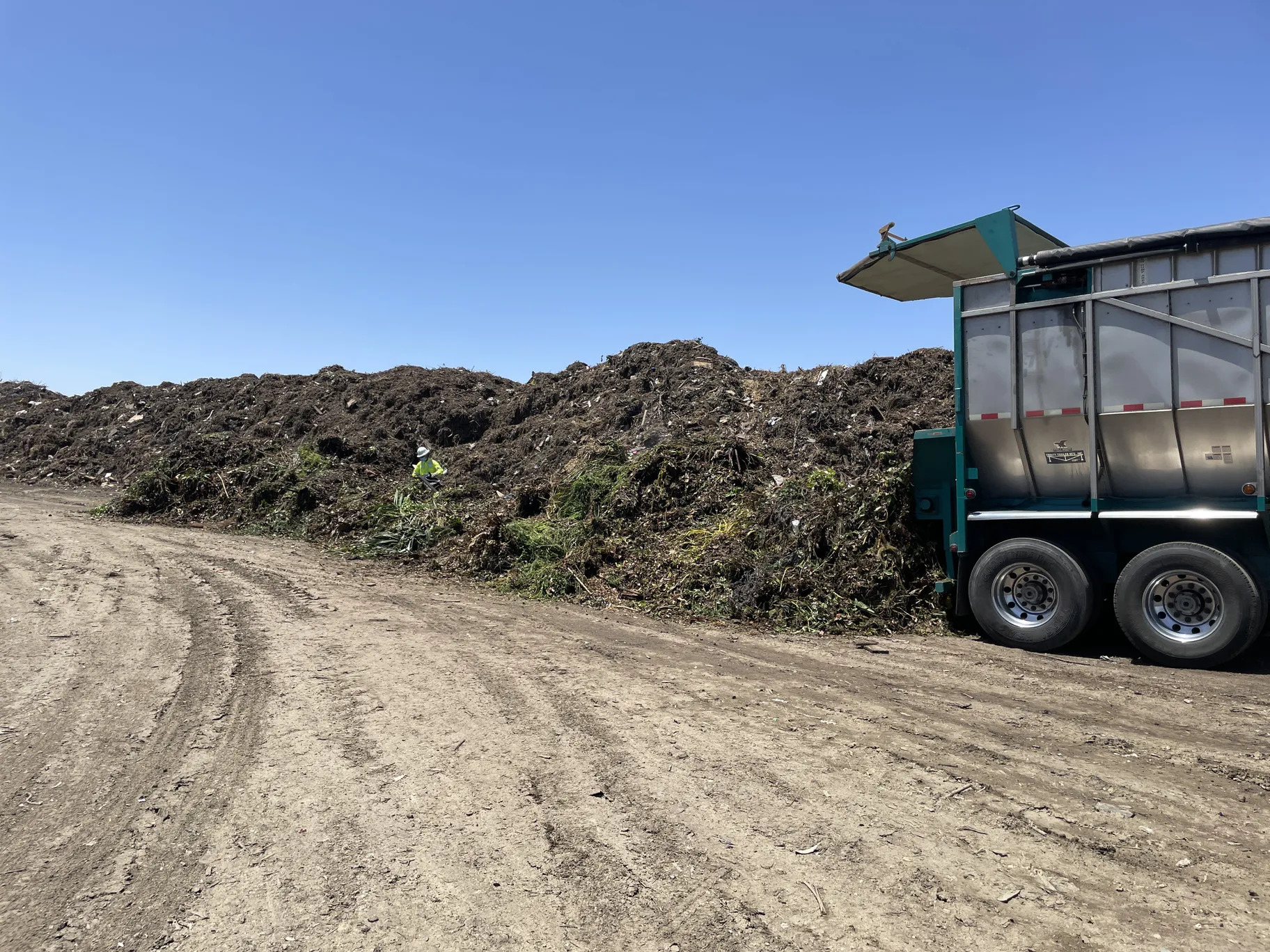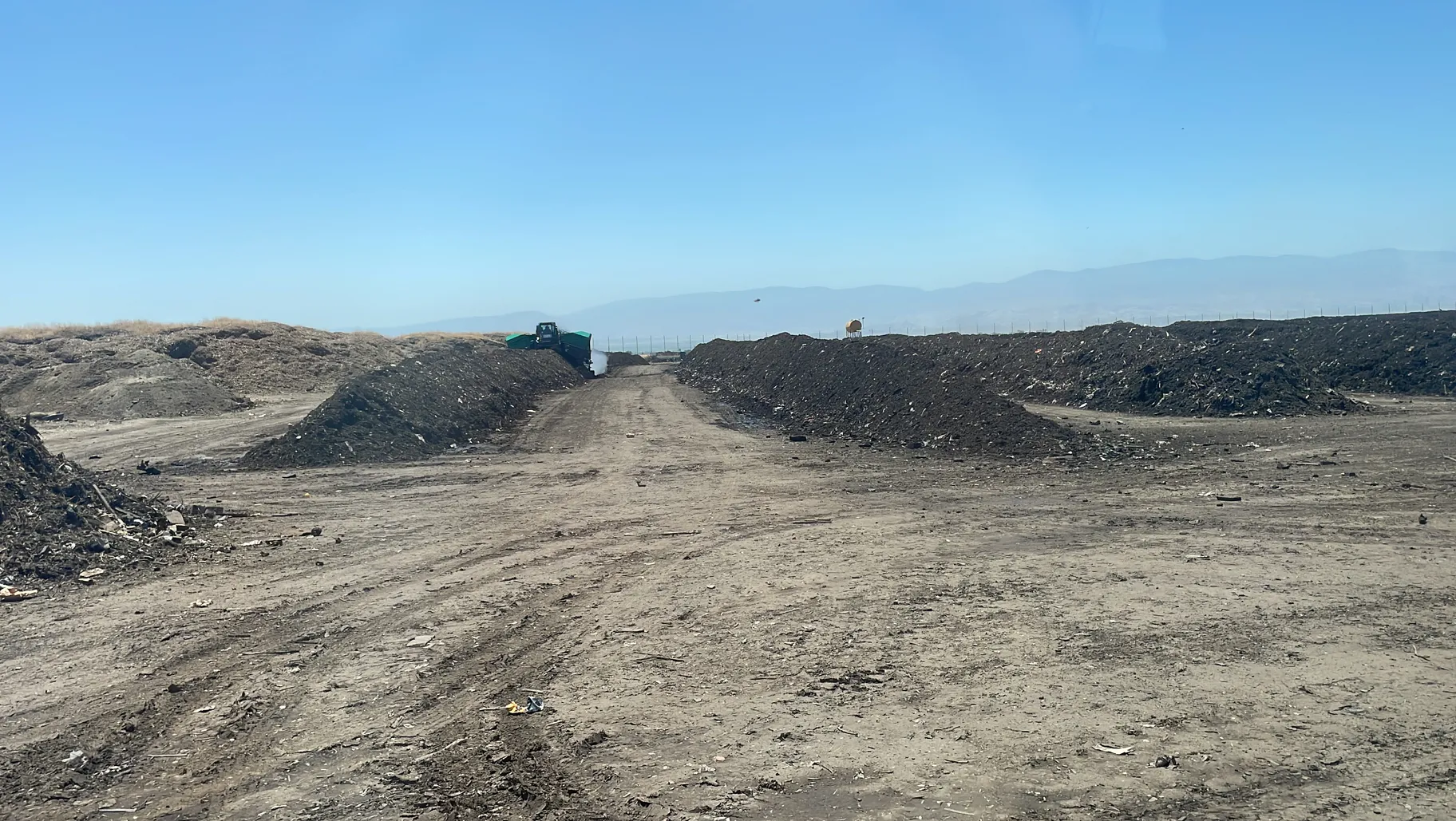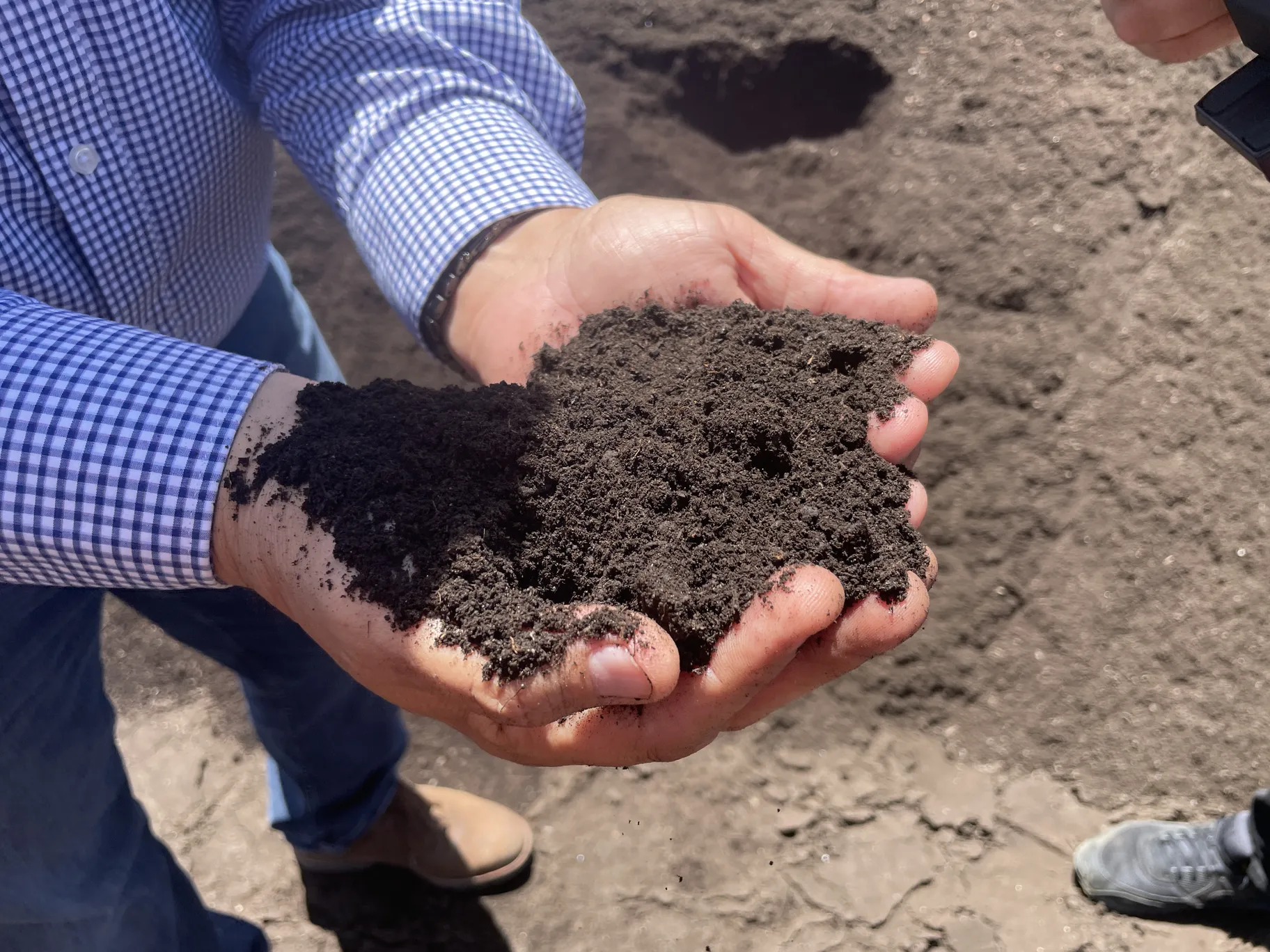You probably already know how food waste processing now works in Los Angeles and lots of other California cities. Just like with your trash, you toss it in a green bin, and a truck shows up to your home every week and carts it off to the great beyond.
But then what happens? Is the moldy, smelly yuck actually getting used? What about all the random trash that gets mixed in (I mean, we’re not all garbage sorting experts)? And sure, it’s better than putting it into a landfill where it will emit planet-heating methane, but are you really reducing greenhouse gas emissions overall?
Actually, yeah. It goes to several processing sites throughout Southern California to become useful compost for local farms.
Step one: the dropoff

A truck that just arrived from LA dumps yard waste and food scraps for their first inspection. Photo by Caleigh Wells.
Those trucks that cart away the organic waste in your green bin combine their hauls and load them onto larger trucks that take them out of town. LA County doesn’t have a major processing center, so for now, many of those trucks go to a large, flat, rural plot of land in Bakersfield. It’s run by a company called Recology, which collects, sorts, and processes waste across the West Coast to divert it from landfill.
LA has 1,800 daily tons of organic waste that gets diverted from the landfill, and the Bakersfield site processes the largest share.
When it first arrives, it looks and smells nothing like finished compost. And about that smell: It’s cheesy and ripe, just like you’d expect of days-old food baking in the sun.
There’s yard waste, tree branches, some recognizable kitchen scraps for sure, plus a lot of other stuff.
The piles contain lots of trash, like an empty fertilizer bag, a milk carton, a garden hose, and countless pieces of tiny unrecognizable plastic. A worker wearing a construction helmet, a reflector vest, and thick gloves wanders around the pile and fixes residents’ mistakes.
“Anything that's bigger that he can physically see, he's going to pull out and move it out of the way,” explains Recology General Manager Sharbel Eid.
The company’s PR manager, Robert Reed, says that afterward, they’re ready to cook up a plant-nourishing brew. “Anything that was ever alive, we're able to compost,” he says. “Steak bones, chicken bones, citrus — things that are more difficult to compost in a backyard composting situation where you don't achieve as much microbial action, and therefore you don't achieve as high temperatures.”
Time for some hot microbial action.
Step two: the shredder

Everything that goes into the shredder comes out in smaller chunks, roughly eight inches or smaller. Photo by Caleigh Wells.
Next, workers feed big chunks of the organic waste into one side of an enormous machine. And on the other side, much like a wood chipper, it spits out chunks that are eight inches or smaller. Now, it’s mostly brown yard waste with bits of green kitchen scraps. Once it’s shredded, the pile joins a 10-foot-tall row of other piles of shredded stuff. The rows stretch on up to 1,000 feet. And there are roughly 150 of them.
Step three: the windrow turner

A giant upside-down U-shaped machine turns the organic waste to keep oxygen flowing to the microorganisms breaking it down into compost. Photo by Caleigh Wells.
Now the microbes take over. Over the course of three months, they turn the eggshells, orange peels, and tree branches into compost that helps the next generation of crops to grow. But they can only do that if they have oxygen.
The windrow turner drives up and down each row every three days, straddling the piles, and dragging a bar that mixes the organic waste so the microorganisms living in it can break down into compost. The steaming heaps reach 150 degrees — hot enough that this reporter’s bare hand couldn’t stand it more than a few seconds before it started to burn.
Step four: the final screening

After three months, smelly organic waste is turned into dark, damp compost. The pungent smell is completely gone. Photo by Caleigh Wells.
There’s one more step before it’s ready to help new plants grow. There are still tiny bits of plastic that workers inevitably couldn’t find and take out. So a machine called the screen plant sifts the pile one last time. There, anything larger than a quarter inch gets sifted out. This is where Recology catches that produce sticker you forgot to pull off your orange peel.
The moldy smell that emanated from the pile three months ago is completely gone and it just smells like wet dirt.
“Now if you're a farmer or gardener, holy cats, man, that looks yummy to you,” says Reed.
Step five: back at the farm

This spreader spews fresh compost over rows of almond tree roots. Photo by Caleigh Wells.
While the food waste had to journey 100 miles to be processed, it only travels 10 minutes down the road to finish its job. Recology estimates more than 95% of the compost it processes gets used locally, in Kern County.
Among the countless farms surrounding the composting facility lies an almond orchard, dotted with rows of large, dark green trees. Now the compost is fed into another machine called a spreader, which drives between rows of almond trees and spews compost out both sides over the tree roots.
“It switches on this life web in the 14 inches of topsoil that grows our food. And that softens the soil,” Reed says. “Then when it rains, or when the farms irrigate, the soil becomes very water efficient.”
So is it helping?
The process is not perfect yet. For now, LA’s food waste makes the trek to Bakersfield on gas-powered trucks, which emit greenhouse gasses. But comparing the two, Reed says it’s worth the tradeoff. Methane emissions from landfill are equal to the annual equivalent greenhouse gas emissions of about 23.1 million cars on U.S. roads. Plus, unlike much of the landfilled organic waste, the compost goes on to serve another purpose.
“Ninety-five percent of the compost ultimately goes onto farms to help California have more healthy soils and grow more food,” he says. “That's good for the economy. That's good for the environment.”
Plus, once it arrives in Kern County, it stays there. Recology estimates more than 95% of the compost it creates is used on local farms.
In the meantime, LA is looking into starting a much smaller project in within city limits. And it offers backyard composting workshops to anybody willing to try it on their own.
“Our ultimate goal is really to be focused on the City of Los Angeles,” says LA Sanitation Assistant Director Alex Helou. “Material generated in the city is composted in the city and given back to the city residents. And the material can also be used at rec and park locations, community gardens and others.”
